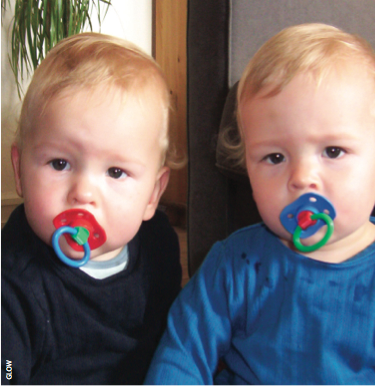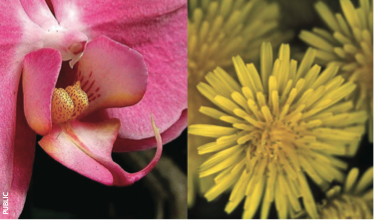SATURDAY, 11 OCTOBER 2014
The question of how much nature and nurture contribute to an individual’s characteristics exerts a special fascination for people. A generation ago, the question was expressed as a debate between the ‘nativist’ school of thought, arguing that the environment is all but unable to influence the destiny written into our genes, and the alternative ‘tabula rasa’ idea that each child is born as a blank slate, waiting to have their identity stamped on them by external forces. Today, research in the field has become more nuanced than this, assuming that both nature and nurture play an important role and aiming to establish how much each mechanism contributes to a particular trait. However, even this attitude, as reflected in popular imagination, misses the point by assuming that nature and nurture make distinct and separable contributions to a given trait. The truth is that an individual is wholly determined by their genes and wholly determined by their environment, at the same time.Let’s start with a typical line of research in this field: a twin study, aimed to establish how much IQ is determined by genes and how much by the environment. A group of monozygotic or identical twins is compared with a group of dizygotic or fraternal twins. Monozygotic twins share 100 per cent of their genes, whereas dizygotic twins are likely to share as much of their genes as any pair of siblings–an average of 50 per cent. By comparing the level of variability in IQ across these two groups, researchers hope to establish how much of this variation can be attributed to the shared genes and how much must be attributed to the environment.
Of course, there are many much discussed flaws with this approach. For example, twins are also likely to share large and difficult to quantify amounts of their environment with one another, such as growing up under the same roof with the same parents. There are ways of solving some of these problems. For example, if you happen to be one of those rare sets of twins adopted into different families, you’re likely to be very popular with genetic researchers. However, methodology aside, the more important question is whether such a distinction between nature and nurture can be quantified in the first place.
Let’s say we have a person with an IQ of 120. This is 20 points higher than we would expect–20 points that need to be attributed to either nature or nurture. Let’s also say the heritability of IQ has been found to be 0.75; that is, 75 per cent of variance
in IQ can be attributed to genes (a similar figure to that found in many studies). This may seem to paint the picture that 75 per cent of an individual’s variability from the norm in IQ is the result of their genes, and the remaining 25 per cent is the result
of their environment. Therefore, perhaps our case study individual gained 15 points of their IQ from their genes, and the remaining 5 points from, say, reading the intellectual books scattered around the house, listening to Mozart in their sleep and their top-drawer education. This intuition – that nature and nurture combine additively to produce the individual variation – is what lies at the heart of the nature/nurture divide. But nature and nurture simply can’t be divided into separate factors in the neat way the additive model implies, as a look at gene-environment interaction shows us.
There are many ways that a genetic trait can interact with the environment it’s placed within. One simple example of this in intelligence is that a genetic predisposition towards intelligence may reinforce itself by selecting environments that boost it further. In other words, a slightly more intelligent than average child will, over time, become exposed to opportunities to increase their intelligence. Praise, encouragement, and of course streaming and a selective education system all contribute to exaggerating small variations in intelligence until they become much bigger. Another example is that genetic predispositions towards other traits, such as good concentration skills or a desire to impress authority figures, may set an individual up to thrive in the educational environment, leading to a boost in IQ. These kinds of gene-environment interactions don’t necessarily undermine our whole understanding of the nature-nurture divide. Although the route from genes to intelligence has become muddied, the basic notion of genes coding for intelligence remains intact.
A more far-reaching effect of gene-environment interaction was posited by Ellis and Boyce upon discovering that some genes seem to dictate the extent to which an individual responds to their environment at all. This is a pattern that has been identified in intelligence as well as other psychological traits such as optimism, alcoholism, and propensity to mental illness. To illustrate it, Ellis and Boyce made a distinction between two types of children: ‘orchid’ and ‘dandelion’ children. Orchid children were those who were genetically predisposed to be sensitive to their environment. If placed in optimal conditions they would thrive but anywhere else they would suffer. Dandelion children, meanwhile, did pretty well in any environment they were placed in. Their conditions didn’t matter as much.
Genes don’t dictate traits in themselves, they dictate how the environment should mould those traits. The two factors combine interactively, not additively. It’s a simple point, but one that shakes the assumption that the influence of genes and of environment can be separated meaningfully. To return to our earlier case study, let’s imagine going back and eliminating all the positive environmental factors on intelligence: the books, the schooling, the positive role models. The additive model, assuming a heritability of 0.75, would predict that this child’s IQ would come out at 115, instead of the earlier 120. The environmental component is gone but the genetic component is left intact. The interactive model, on the other hand, suggests that the effect on this child depends on whether or not they are an orchid or a dandelion. If they are an orchid, their IQ may plummet far lower than 5 points and if a dandelion, it might remain unchanged.
The additive model of genes and environment simply doesn’t stack up. Any gene requires interaction with a certain kind of environment in order to manifest itself. For instance, a baby with the genes for an intelligence of 95, height of 180cm, and a penchant for French indie films won’t acquire any of those traits if it’s born on the surface of Mars. We need to throw out this assumption of a linear stacking effect of genes and environment, and replace it with a multiplicative one. Under this new framework, the question of whether it is nature or nurture that contributes more to an individual’s traits stops making sense. In the words of Donald Hebb, this question is equivalent to asking “Which contributes more to the area of a rectangle, its length or its width?” The answer is that the area of a rectangle is wholly dependent on its length and wholly dependent on its width. Both are essential for the rectangle to have any area at all, and without knowledge of both, it’s impossible to guess what the final product will be. In a similar way, it’s impossible to examine nature and nurture separately, both are essential to the development of an individual.
Alex O’Bryan-Tear is a 3rd year PhD student in the Department of Psychiatry.





